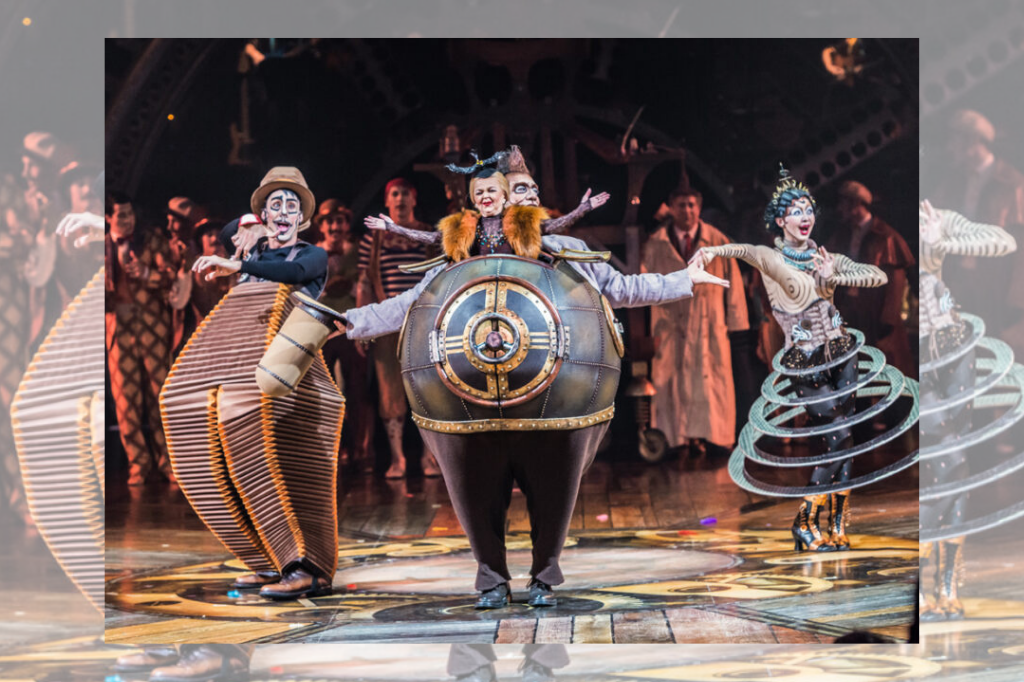REVIEW: Kurios at Cirque du Soleil
I remember vividly the first time I saw a Cirque du Soleil show.
I was eleven and in budget-friendly seats at an arena in downtown Baltimore. The piece was Totem, directed by Robert Lepage, about human evolution and (loosely, shallowly) inspired by Indigenous spirituality. It was peak Soleil, acrobatics and spectacle and overpriced popcorn. Though at the time I don’t think I loved it (I was more confused than amazed, as I’ve never done well with performances without explicit stories), Totem formed a lasting, if frugal memory in my brain.
I didn’t know about the string of near-bankruptcies and bad press for the company. As I got older, it didn’t occur to me that the most recognizable name in circus around the world was in trouble, and even more so once the pandemic hit — articles to that effect simply didn’t capture my attention.
Now, in the hours following my venture into Kurios-ity, I can’t imagine a further departure from the Soleil of my tweenage memories and doomy headlines.
If Soleil remains in financial trouble, the VIP experience the company offered press (and a few Toronto Raptors, to my amusement) for opening night didn’t explicitly give that away. The red-carpeted tent featured the most open of bars, gorgeous catering, and free merch in branded tote bags. Gleaned while drafting this review: when sold for future performances, those VIP tickets are a steep $316 CAD plus fees (non-VIP tickets are a much more reasonable $66), perhaps offsetting the truly spectacular number of freebies at opening. The VIP experience on Thursday was one of opulence: I don’t know if it’s worth that price tag, and I’d certainly not pay that myself, but if the company was trying to put on a brave face, sweet-talk some media and influencers, and make for a memorable opening, hey, it worked.
Kurios first opened in Montreal in 2014 and was a critical darling in Toronto and beyond. It’s unsurprising the inventive aesthetic romp through steampunk is what’s been chosen to welcome audiences back to the big top. The Soleil of my childhood memories was long, meandering — Kurios, on the contrary, ended all too quickly, after two acts’ worth of wonder and glittering talent. At the risk of contributing to journalistic cliché, yes, Cirque du Soleil is absolutely the best possible return to live performance post-pandemic: Kurios boasts a balance of ephemerality and spectacle which simply can’t have been replaced by digital media over the last two years.
The music by Bob & Bill (they’re not billed with last names) and Raphaël Beau is intoxicatingly catchy and walks a delicate line between electronic and swing beats — in other words, there will be musical moments audience members of all ages and most tastes will enjoy, especially given that the music is performed live by a fantastic pit band. Costumes, in typical Soleil fashion, range from cartoonishly large to effortlessly chic, paying homage to traditional striped circus attire and Victorian-ish garb alike. Designed by Philippe Guillotel, the costumes of Kurios shape the enormous ensemble into a cohesive aesthetic unit: it’s a smorgasbord of steampunk. In tandem with music which could be straight from the 2013 Baz Luhrmann adaptation of The Great Gatsby, Kurios’ design is a visual feast fit for the most roaring of twenties.
Kurios’ story is… thin. Let’s be real: that’s not why you’re there. A ticket to Cirque du Soleil is a promise of departure from the real world, a ticket to whimsy and magic: when the stagecraft is so strong, as it is here, no story’s really needed, more so just a visual idea to weave different elements together. Per the Cirque du Soleil website, the story is as follows: a “Seeker” believes a hidden world exists in his curio cabinet. It does, and the Seeker’s paid visits by an outlandish cast of characters straight from his own imagination. Reality and psyche intersect, and the stuff of dreams comes to physical fruition.
Sure. I have no trouble buying that — it just doesn’t come through particularly clearly. No matter.
Soleil is synonymous with spectacle, and on opening night, that’s precisely what we got. No basket tosses, sky-high trampoline jumps, or tumbling passes were marked or missed; no juggled pins were dropped; no acrobats fell into safety nets. Circus is a new world to me — if there were any lapses in technique, they went unnoticed. In the absence of story there was precision and endless wow factor: after two years of binging Cheer and Dance Moms, admiring the capabilities of young gymnasts and contortionists, how glorious it was to see those feats of stagecraft happen up close and from a corps of professionals. Lighting, too, in an excellent design by Martin Labrecque, is both efficient and spectacular — surprise entrances are masked as needed, and ensemble numbers are uniformly lit, but Kurios also finds occasional moments for Labrecque’s design to take breathtaking centre stage. At times, it’s truly mesmerizing.
Circus will never be without its problems, of course. P.T. Barnum notably abused his animals, including the St. Thomas, ON-landmarked Jumbo the Elephant. Soleil performers sometimes fall from those breathtaking heights. There’s a long relationship between circus and so-called freak shows. This iteration of Cirque du Soleil’s not interested in addressing that history, and in fact contributes to it: Mini Lili, a very small woman, is the centrepiece of much of Kurios. Her job within Soleil is not a learned skill like contortionism or trapeze or tumbling: it’s her smallness. The targeted gaze towards atypical bodies is nothing new, unfortunately, and it’s a concern braided into an industry which extends far beyond the company’s circus tents — a tradition of ableism isn’t Soleil’s fault, necessarily, but it’s frustrating that no visible steps have been taken to destabilize that murky past. Russian Antanina Satsura, who plays Mini Lili, is at peace with her role in the circus — she gave a fantastic interview on her career during a 2016 Kurios stop in Boston — and yet her presence still sets off alarm bells for possibilities of exploitation.
Kurios seems to be a solid outing for Cirque du Soleil, a visually gorgeous affair rife with surprises. Cirque du Soleil’s unwillingness to engage with or rectify years of financial and representational controversy is troubling — more so knowing the company entered even more PR hot water earlier this year by deepening business ties with Saudi Arabia. The show, save for some questionable representation, is fantastic: its context is a mess. Both can be true. Kurios is a delight, and opening night was the gala event of fantasy: we’ll see if the Toronto stop on what seems to be an endless tour gestures towards recovery for the company at large.
Kurios runs until July 17 at Ontario Place. Tickets are available here.















Comments